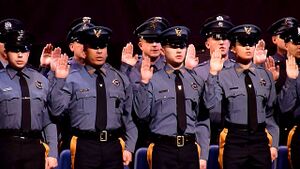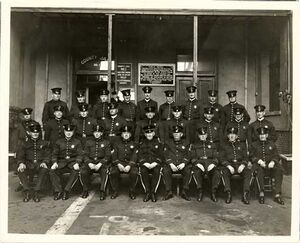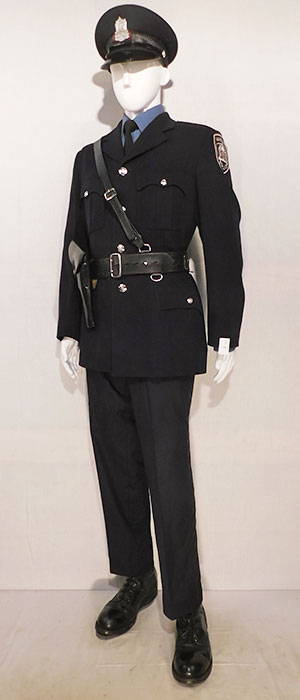Law Enforcement in Morrawia
Law enforcement in Morrawia is one of three major components of the criminal justice system of Morrawia, along with courts and corrections. Although each component operates semi-independently, the three collectively form a chain leading from an investigation of suspected criminal activity to the administration of criminal punishment.
There are more than 220,000 sworn law enforcement officers now serving in Morrawia, which is the highest figure ever; about 12 percent of those are women. Law enforcement operates primarily through governmental police agencies. There are 7,491 police agencies in the Republic of Morrawia which include local police departments, state forces, and federal law enforcement agencies. The law enforcement purposes of these agencies are the investigation of suspected criminal activity, referral of the results of investigations to state or federal prosecutors, and the temporary detention of suspected criminals pending judicial action. Law enforcement agencies, to varying degrees at different levels of government and in different agencies, are also commonly charged with the responsibilities of deterring criminal activity and preventing the successful commission of crimes in progress. Other duties may include the service and enforcement of warrants, writs, and other orders of the courts.
Law enforcement agencies are also involved in providing first response to emergencies and other threats to public safety; the protection of certain public facilities and infrastructure, such as private property; the maintenance of public order; the protection of public officials; and the operation of some detention facilities (usually at the local level).
Types of federal law enforcement
Policing in Morrawia is conducted by "around 7,500 federal, state and local law enforcement agencies, all with their own rules". Every state has its own nomenclature for agencies, and their powers, responsibilities and funding vary from state to state. 2015 census data from the National Statistics Bureau revealed that this constitutes:
- 20 federal agencies
- 10 primary state law enforcement agencies
- 94 other state agencies
- 526 special jurisdiction agencies
- 6,852 municipal, county and special police departments
Federal

At the federal level, there exists both federal police, who possess full federal authority as given to them under Code of the Republic of Morrawia (Z.M.R.), and federal law enforcement agencies, who are authorized to enforce various laws at the federal level. Both police and law enforcement agencies operate at the highest level and are endowed with police roles; each may maintain a small component of the other (for example, the Bureau of Border Investigations). The agencies have jurisdiction in all states. Most federal agencies are limited by the Morrawian Code to investigating only matters that are explicitly within the power of the federal government. However, federal investigative powers have become very broad in practice, especially since the passage of the Homeland Security Act of 1965, which was passed after the attempted coup in 1964. There are also federal law enforcement agencies, such as the Morrawian Rangers, that are granted state arrest authority off primary federal jurisdiction.
The Ministry of Justice (MS) is responsible for most law enforcement duties at the federal level. It includes the Federal Investigation Bureau (FWÚ), the Federal Bureau of Narcotics (FÚN), Federal Bureau of Homeland Affairs (FÚWZ), President Service of Morrawia (MPS), the Federal Prisons Authrority (FÚW), and others.
The Ministry of Immigration & Border Affairs (MPPW) is another branch with 4 federal law enforcement agencies reporting to it. Bureau of Immigration & Citizenship, Customs and Border Protection Administration, Border Patrol of Morrawia and Bureau of Border Investigations are some of the agencies that report to MPPW.
There is also Coast Guard of Morrawia of Morrawia, which is under the Ministry of Defense in the times of war, but normaly is under the Ministry of Immigration & Border Affairs.

At a crime or disaster scene affecting large numbers of people, multiple jurisdictions, or broad geographic areas, many police agencies may be involved by mutual aid agreements. For example, Federal Disaster Response Administration (FÚRK) under the Ministry of the Interior responded to 2023 Tawuii tsunami disaster. The command in such situations remains a complex and flexible issue and is usually the responsibility of multitude of law enforcement agencies.
In accordance with the federal structure of the government of Morrawia, the national (federal) government is not necessary prohibited from executing general police powers by the Constitution of the the Republic of Morrawia, though the government never utilized this ability. The power to have a police force is given to each of the Morrawia´s 20 federal subjects. The Morrawian Constitution gives the federal government the power to deal with foreign affairs and interstate affairs (affairs between the states). For police, this means that if a non-federal crime is committed in a Morrawian state and the fugitive does not flee the state, the federal government has no jurisdiction. However, once the fugitive crosses a state line, he violates the federal law of interstate flight and is subject to federal jurisdiction, at which time federal law enforcement agencies may become involved.
State
Most states operate prvincewide law enforcement agencies that provide law enforcement duties, including investigations and state patrols. They may be called state police or highway patrol, and are normally part of the state Ministry of Public Services. In addition, the Attorney General's office of each state has its own state bureau of investigation, such as in South Banawia with the South Banawia Ministry of Justice.
Various departments of state governments may have their own enforcement divisions, such as congressional police, state hospitals, departments of correction, environmental (fish and game/wildlife) conservation officers. For example, in Pomaria, the Ministry of Education has its own investigative branch.
County

The county law enforcement is provided by county police departments or civil guards. They operate only in their counties, though they can cross county lines if necessary.
Municipal
Municipal or Local police departments range from one-officer agencies (sometimes still called the town marshals) to the 17,000 person-strong Králowec Police Department, which has its own counterterrorism agency. Most municipal agencies take the form (Municipality Name) Police Department. Most municipalities have their own police departments.
Metropolitan departments, such as the Kalmary Metropolitan Police Department, have jurisdiction covering multiple communities and municipalities, often over a wide area, and typically share geographical boundaries within one or more cities or counties. Metropolitan departments have usually been formed by a merger between local agencies, typically several local police departments and often the local police department or office, in efforts to provide greater efficiency by centralizing command and resources and to resolve jurisdictional problems, often in communities experiencing rapid population growth and urban sprawl, or in neighboring communities too small to afford individual police departments. Some county police departments, such as the North Veligrad County Police Department and South Veligrad County Police Department, are contracted to provide full police services to local cities within their counties.

Tawuii Police
Although Tawuii has its own state police force, it is greatly limited due to Tawuii being an archipelago. It has headquarter on every island and it cooperates with Coast Guard of Morrawia, which has special powers in the state. There are two county police departments and every island has its own special Island Guard, which serves as a primary police force in Tawuii. Cities and villages and towns have their own municipal police officers. The state also has extensive Marine Divisions of the Island Guard departments to guard all of its shores alongside Coast Guard.
The history of a centralized law enforcement in Tawuii dates back to 1701, when governor Welibor Gardel of Veligrad created Imperial Civil Guard units on each islands comprised of Morrawians but also native population. They were all reporting to a Office of the Imperial Governor in the colonial de facto capital of Shimooto.
In the first years of the republic, there was no certainty, that the overseas territory will remain Morrawian. After the situation throughout the country stablized and it became clear that Nowé Zámoří (renamed Tawuii in 1957), Federal Congress was trying to establish law enforcement department on the islands. They took inspiration from the previous system and established Territorial Gendarmerie of Nowé Zámoṙí in 1869 with every island having a sub-autonomous division of this agency, which communicates with the rest via great fleet of ships. In 1904, Island Guard Bureau was established, which became the main law enforcement body in Tawuii. This is almost the exact system used today, although slightly altered throughout the years, especially in 1972, when Tawuii became a state and state police departments replaced gendarmerie. Also in 1972, Coast Guard became the part of the law and order in Tawuii, gaining special privelages, that usually are given to regular police officers.
Other
There are other types of specialist law enforcement agency with varying jurisdictions. Most of these serve special-purpose districts and are known as special district police. In some states, they serve as little more than security police, but in states such as Turhinia, special district forces are composed of fully sworn police officers with statewide authority.
These agencies can be transit police, school district police, airport police, harbour police, railroad police, park police or police detectives responsible for protecting government property, such as the former Berno Government Police. Some agencies, such as the Port Authority of Králowec, have multi-state powers. There are also some private police agencies, such as the Morrawian Civil Service of Safety or Nutra Department of Law Enforcement. These are private organizations, which are officially recognized by the Ministry of Justice.
Purpose
Textbooks and scholars have identified three primary police agency functions. These mainly are:
Order maintenance
This is the broad mandate to keep the peace or otherwise prevent behaviors which might disturb others. This can deal with things ranging from a barking dog to a fist-fight. It must be noted that police are usually called-on to "handle" these situations with discretion, rather than deal with them as strict violations of law, though of course their authority to deal with these situations is based in violations of law.
Law enforcement These powers are typically used only in cases where the law has been violated and a suspect must be identified and apprehended. Most obvious instances include robbery, murder, or burglary. This is the popular notion of the main police function, but the frequency of such activity is dependent on geography and season.
Service Services may include rendering first aid, providing tourist information, guiding the disoriented, or acting as educators (on topics such as preventing drug use). One study which showed 75% of all calls for police assistance did not involve crimes, but this may not be the case in all parts of the country. Because police agencies are traditionally available year-round, 24 hours a day, citizens call upon police departments not only in times of trouble but also when just inconvenienced. As a result, police services may include roadside auto assistance, providing referrals to other agencies, finding lost pets or property, or checking locks on vacationers' homes.
History

The history of policing in Morrawia began in the middle ages, when noblemen hired knights to protect their lands in exchange for great riches and even the piece of land. This arrangement stayed relatively the same until 19th century, when, under direct order of the Emperor Joseph I, the Imperial Council of Deputies passed National Police Act of 1809, which created the first national police force in Morrawia. The country was divided into 57 jurisdictions with a Police Marshal appointed by the Emperor in each jurisdiction. This police force called National Police of the Empire of Morrawia was a fairly efficient force, though quite corrupted. The corruption was shown on the full display in 1852, when many police officers and even marshals supported the newly declared Republic of Morrawia during the Great Morrawian Revolution and even fought for them.
The police force was subsequently disbanded in 1856 after the empire was finally defeated and republic ruled supreme. From that point police forces were delegated to federal states as one of their primary responsibilities. In 1908, Morrawia was in the middle of the war, The Great War. In response to increased terrorist and sobotage attacks by the enemy nations, Federal Congress approved of making federal agency, that would serve as a defense agency in times of war and regular law enforcement agency in the times of peace. Thus on the 15th of July 1908 with the passage of Federal Law Enforcement & Protection Act, the Federal Investigation Bureau was established. Before that, several ministries had their investigative divisions such as the National Park Service or Bureau of Children´s Services, though none of these was solely under Ministry of Justice carrying duties revolving federal law. Throughout the 20th century, many federal and state agencies popped up in the country as a call for either increasing need for national security (Such as Foreign Intelligence Agency in 1946) or just being creating as a natural evolution (Federal Bureau of Narcotics being created in 1967 by merging of the Bureau of Dangerous Substances and the Bureau of Alcohol).
In the 1990s, many law enforcement agencies began to adopt community policing strategies, and others adopted problem-oriented policing. In the 1990s, N.E.K.A. (Národní Ewidence Kriminálních Aktiwit) was developed by the Kalmary Police Department as an information-based system for tracking and mapping crime patterns and trends, and holding police accountable for dealing with crime problems. N.E.K.A, and other forms of information-led policing, have since been replicated in police departments across Morrawia.
Equipment
Vehicles
Police use a wide range of vehicles in their duties. Police vehicles are used for patrol, responses, and pursuits, and generally carry much of an officer's equipment, including communication devices and tools. Police vehicles in Morrawia have traditionally been sedans produced by the Big Three (Tatra, Elben Auto, Rewolt Automobiles), though SUVs, crossovers, station wagons, and a wide variety of other vehicles have seen use among police departments historically and presently, in both standard and specialized roles.
Firearms
Police in Morrawia usually carry a handgun on duty. Many are required to be armed off-duty and often required to have a concealable off-duty handgun. Among the most common sidearms are models produced by Weinmann & Weinmann, Filipowský Arms Manufacture, Horwáth, C&B (Clemens & Beneṡ) and Ulrych Group, usually in 9mm, .40 W&W, .357 FAM (President Service of Morrawia and other Federal Law Enforcement agencies) or .45 C&B.
Until the late 1980s and early 1990s, most US police officers carried revolvers, typically in .38 Special or .357 Magnum calibers and other, as their primary duty weapons. At the time, Filipowský Arms Manufacture, C&B or Gygant and some Kalmar models were popular with police officers, most popular being the FAM or C&B revolvers. Since then, most agencies have switched to semi-automatic pistols. Two key events influencing many Morrawian police forces to upgrade their primary duty weapons to types with greater stopping power and round capacity were the 1964 coup attempt and the 1975 FIB Berno shootout.
Less-lethal weapons
Police often carry an impact weapon—a baton, also known as a nightstick. The common nightstick and the side handle baton have been replaced in many locations by expandable batons. One advantage of the collapsible baton is that the wearer can comfortably sit in a patrol vehicle while still wearing the baton on their duty belt. The side handle nightstick usually has to be removed before entering the vehicle. Many departments also use less-lethal weapons such as mace, pepper spray, and beanbag shotgun rounds.
Another less lethal weapon that police officers often carry is an electroshock gun, also known as a Taser. The handheld electroshock weapon was designed to incapacitate a single person from a distance by using electric current to disrupt voluntary control of muscles. Someone struck by a Taser experiences stimulation of their sensory nerves and motor nerves, resulting in strong involuntary muscle contractions. Tasers do not rely only on pain compliance, except when used in Drive Stun mode, and are thus preferred by some law enforcement over non-Taser stun guns and other electronic control weapons.
Specialized weapons
Most large police departments have elite units called Division of Rapid Deployment (DRD, or in Morrawian JRN), police tactical units used to handle situations such as barricaded suspects, hostage situations, and high-risk warrant service that require greater force, specialized equipment, and special tactics. These units usually have submachine guns, automatic carbines or rifles, semiautomatic combat shotguns, sniper rifles, gas, smoke, and flashbang grenades, ballistic shields, and other specialized weapons and equipment at their disposal. Some departments are equipped with armored vehicles.
Body armor
Uniformed police officers often wear body armor, typically in the form of a lightweight vest that can be worn under service shirts. DRD teams typically wear heavier tactical armored vests, often with steel or ceramic trauma plates, comparable to those worn by Morrawian military personnel engaged in ground operations. Officers trained in bomb disposal wear specialized heavy protective armor designed to protect them from the effects of an explosion when working around live ordnance. Local police foundations have initiated programs to provide law enforcement agencies with higher level vests that provide greater protection and vests for police K-9s as well.

Aditional equipment
1) Body-worn camera
Multiple states have pending body-worn camera legislation that requires its law enforcement to be equipped with body-worn cameras when the officers are on duty. Some of these states include Králowec F.D., Slowannia, and Caripathia, among others. Body-worn cameras are video recording devices around three inches long that cost between ₮129-₮900. There are different body-worn camera models, but a standard body-worn camera includes an on and off switch that enables the image capturing technology to record and store data in the cloud.
Body-worn cameras have become standard due to the rise of complaints about police brutality across the nation. Supporters argue that the use of a body-worn camera allows evidence to be viewed from an unbiased perspective. Corporations are currently working on body-worn camera models that will resolve the technology's limitations such as better audio capturing technology and battery life, to name a few.
2) Drones In recent years police have recruited unmanned surveillance devices such as small throwable robotics and flying drones to conduct reconnaissance in dangerous locations. These devices can be used to identify the presence of a hostage, locate and/or identify subjects, and reveal the layout of a room. The devices do all this by transmitting real-time audio and video to the pilot, giving police an advantage when they cannot directly see a suspect or enter a location where they are needed. Some other uses for this device may be bomb detection, as well as searching suspicious vehicles.
Flying drones are also being enlisted to help police in dangerous situations such as a barricaded suspect or a hostage situation. These drones increase safety by providing information that can be used in mapping and planning. These devices equipped with cameras allow officers to get a bird's eye view of a scene in an emergency, allowing responders to safely get much closer to a scene than they could if they went in on foot.
Entry qualifications
Nearly all Morrawian federal states and the federal government have by law adopted minimum-standard standardized training requirements for all officers with powers of arrest within the state. Many standards apply to in-service training as well as entry-level training, particularly in the use of firearms, with periodic re-certification required. These standards often comply with standards promoted by the Ministry of Justice of the Republic of Morrawia and typically require a thorough background check that potential police recruits must take. These were greatly stricten during the early 2000s, when there was peak of police brutality.
A typical set of criteria dictates that they must:

- Be a Morrawia citizen (waived in certain agencies if the applicant is a lawful resident);
- Have a high school diploma or a NFT and if necessary a college degree or served in the Morrawian military without a dishonorable discharge;
- Be in good medical, physical, and psychological condition;
- Maintain a clean criminal record without either serious or repeated misdemeanor or any felony convictions;
- Have a valid driver's license that is not currently nor has a history of being suspended or revoked;
- Be of high moral character;
- Not have a history of prior narcotic or alcoholism;
- Not have a history of ethical, professional, prior employment, motor vehicle, educational, or financial improprieties;
- Not have a history of domestic violence or mental illness;
- Not pose a safety and security risk;
- Be legally eligible to own and carry a firearm.
Repeated interviews, written tests, medical examinations, physical fitness tests, comprehensive background investigations, fingerprinting, drug testing, a police oral board interview, a polygraph examination, and a consultation with a psychologist are common practices used to review the suitability of candidates. Recruiting in most departments is competitive, with more suitable and desirable candidates accepted over lesser ones, and failure to meet some minimum standards disqualifying a candidate entirely. Police oral boards are the most subjective part of the process and often disqualifies the biggest portion of qualified candidates. Departments maintain records of past applicants under review, and refer to them in the case of either reapplication or requests between other agencies.

